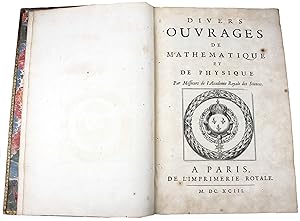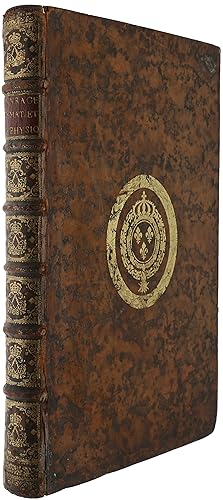roberval picard huygens frenicle (2 résultats)
Type d'article
- Tous les types d'articles
- Livres (2)
- Magazines & Périodiques
- Bandes dessinées
- Partitions de musique
- Art, Affiches et Gravures
- Photographies
- Cartes
-
Manuscrits &
Papiers anciens
Etat
- Tous
- Neuf
- Ancien ou d'occasion
Reliure
- Toutes
- Couverture rigide (1)
- Couverture souple
Particularités
- Edition originale
- Signé
- Jaquette
- Avec images
- Sans impression à la demande
Livraison gratuite
Pays
Evaluation du vendeur
-
Divers ouvrages de mathématique et de physique. Par Messieurs de l'Académie royale des sciences
Edité par Imprimerie Royale, Paris, 1693
Vendeur : Hugues de Latude, Villefranche de Lauragais, France
Membre d'association : ILAB
Edition originale
*** Première édition. Elle comprend 31 essais, la plupart en édition originale par Roberval, Huygens, Picard, Frénicle de Bessy, Auzout, Ole Römer and Mariotte : 9 par Roberval, 8 par Huygens, 5 par Picard, 4 par Frénicle de Bessy, 2 par Auzout, 2 par Ole Römer et 1 par Mariotte. Après la mort de Frénicle et Roberval, leurs ouvrages, restés manuscrits, furent confiés à Picard. Ce dernier, étant mort en 1682, tous ces manuscrits passèrent entre les mains de La Hire, qui les a publiés dans le présent ouvrage, avec ceux de Picard et quelques mémoires de Huygens. Roberval n'a publié que deux ouvrages de son vivant. On trouve ici ses mémoires les plus importants, qui n'avaient jamais été encore publiés: - Observations sur la composition des mouvements. - Projet d'un livre de méchanique, traitant des mouvements composés. - Traité des indivisibles. - De Trochoïde ejusque spatio. DSB 11, 486-490. Ce volume contient aussi : Frénicle de Bessy: - Méthode pour trouver la solution des problèmes par exclusions. - Abrégés des combinaisons. - Des carrés ou tables magiques. DSB 5, 158. Picard: - De la pratique des grands cadrans par le calcul. - De mensuris. - De mensura liquidorum & aridorum. -Fragmens de dioptrique. DSB 10, 395. Huygens: - De la cause de la pesanteur. - Démonstration de l'équilibre de la balance. - Construction d'un problème d'optique. L'ouvrage s'achève sur un mémoire de Mariotte: - Règles pour les jets d'eau, qui est suivi de deux courts mémoires de Römer. Nombreuses figures dans le texte. Exemplaire aux armes de Louis XIV sur les plats (Olivier 2494, fer 10) et son fleuron entre les nerfs. L'Académie des Sciences fut fondée par Colbert en 1666 et reçut l'approbation de Louis XIV en 1699. Toutes petites piqûres de vers (de la taille d'une épingle) dans la marge intérieure, quelques feuillets brunis en début d'ouvrage, très discrètes restaurations à la reliure. Très bel exemplaire de ce livre fort rare. *** In-folio de (6), 518, (1) pp. Veau marbré, dos à nerfs orné, armes de Louis XIV dorées sur les plats, tranches mouchetées. (Reliure de l'époque.) - - - - - - - - - - - - - - - - - - - - - - - - - - - - - - - - - - - - - - - - - - - - - - - - - - - - - - - - - - - - - - - - - - - - * First edition of this collection of texts by Roberval, Huygens, Picard, Frénicle de Bessy, Auzout, Ole Römer and Mariotte. Most of them are published for the first time. Contemporary binding with the arms of Louis XIV. - -.
-
Divers ouvrages de mathématique et de physique
Edité par L'Imprimerie Royale, Paris, 1693
Vendeur : SOPHIA RARE BOOKS, Koebenhavn V, Danemark
Membre d'association : ILAB
Edition originale
Hardcover. First edition. A ROYAL PRESENTATION BINDING. First edition of this superb collection of thirty-one treatises by the leading scientists of seventeenth-century France, almost all of which are published here for the first time. This is one of the earliest important publications of the Académie des Sciences, and one of the most magnificent, and the present copy was probably intended for presentation: it is bound in contemporary calf with the arms of Louis XIV on each cover. Founded on 22 December 1666, one of the principal functions of the Académie was to facilitate publication of the works of its members. Frenicle and Roberval were founding members (as was Huygens), and without the assistance of the Académie it is likely that many of their works would have remained unpublished (only two works by Frenicle and two by Roberval were published in their lifetimes). After the death of Frenicle and Roberval in 1675, their books and manuscripts were entrusted to the astronomer Jean Picard; eight treatises by Huygens were also sent to Picard for publication in this collection. After Picard's death in 1682, publication of the works was brought to fruition by Philippe de la Hire. La Hire also included in the Divers ouvrages five treatises by Picard himself, including an unusual 37-page work on dioptrics, one by Mariotte and two each by Auzout and Rømer. The most important work in the volume is probably Roberval's Traité des indivisibles, composed around the same time as Cavalieri's Geometria indivisibilibus (1635) but independent of it and published here for the first time. The treatises by Frenicle, a close correspondent of Fermat, treat topics in number theory and related fields. See below for a full list of contents. Gilles Personne de Roberval (1602-75) arrived in Paris in 1628 and put himself in contact with the Mersenne circle. "Mersenne, especially, always held Roberval in the highest esteem. In 1632 Roberval became professor of philosophy at the Collège de Maître Gervais. On 24 June 1634, he was proclaimed the winner in the triennial competition for, the Ramus chair (a position that he kept for the rest of his life) at the Collège Royal in Paris, where at the end of 1655 he also succeeded to Gassendi's chair of mathematics. In 1666 Roberval was one of the charter members of the Académie des Sciences in Paris . He himself published only two works: Traité de méchanique (1636) and Aristarchi Samii de mundi systemate (1644). A rather full collection of his treatises and letters was published in the Divers ouvrages de mathématique et de physique par messieurs de I'Académie royale des sciences (1693), but since few of his other writings were published in the following period, Roberval was for long eclipsed by Fermat, Pascal, and, above all, by Descartes, his irreconcilable adversary. "Roberval was one of the leading proponents of the geometry of infinitesimals, which he claimed to have taken directly from Archimedes, without having known the work of Cavalieri. Moreover, in supposing that the constituent elements of a figure possess the same dimensions as the figure itself, Roberval came closer to the integral calculus than did Cavalieri, although Roberval's reasoning in this matter was not free from imprecision. The numerous results that he obtained in this area are collected in the Divers ouvrages, under the title of Traité des indivisibles. One of the first important findings was, in modern terms, the definite integration of the rational power, which he most probably completed around 1636, although by what manner we are not certain. The other important result was the integration of the sine . the most famous of his works in this domain concerns the cycloid. Roberval introduced the "compagne" ("partner") of the original cycloidal curve and appears to have succeeded, before the end of 1636, in the quadrature of the latter and in the cubature of the solid that it generates in turning around its base . "On account of his method of the "composition of Movements" Roberval may be called the founder of kinematic geometry. This procedure had three applications-the fundamental and most famous being the construction of tangents. "By means of the specific properties of the curved line," he stated, "examine the various movements made by the point which describes it at the location where you wish to draw the tangent: from all these movements compose a single one; draw the line of direction of the composed movement, and you will have the tangent of the curved line." Roberval conceived this remarkably intuitive method during his earliest research on the cycloid (before 1636). At first, he kept the invention secret, but he finally taught it between 1639 and 1644; his disciple François du Verdus recorded his lessons in Observations sur la composition des mouvemens, et sur le moyen de trouver les touchantes des lignes courbes . In the second place, he also applied this procedure to comparison of the lengths of curves, a subject almost untouched since antiquity . The third application consisted in determining extrema . "Roberval composed a treatise on algebra, De recognitione aequationum, and another on analytic geometry, De geometrica planarum et cubicarum aequationum resolutione. Before 1632, he had studied the "logistica speciosa" of Viète; but the first treatise, which probably preceded Descartes's Géométrie, contains only the rudiments of the theory of equations. On the other hand, in 1636 he had already resorted to algebra in search of a tangent. By revealing the details of such works, he would have assured himself a more prominent place in the history of analytic geometry, and even in that of differential calculus . "In 1647 [Roberval] wrote to Torricelli: "We have constructed a mechanics which is new from its foundations to its roof, having rejected, save for a small number, the ancient stones with which it had been built" (p. 301) . around 1669, Roberval wrote Projet d'un livre de mechanique traitant des mouvemens composez.



